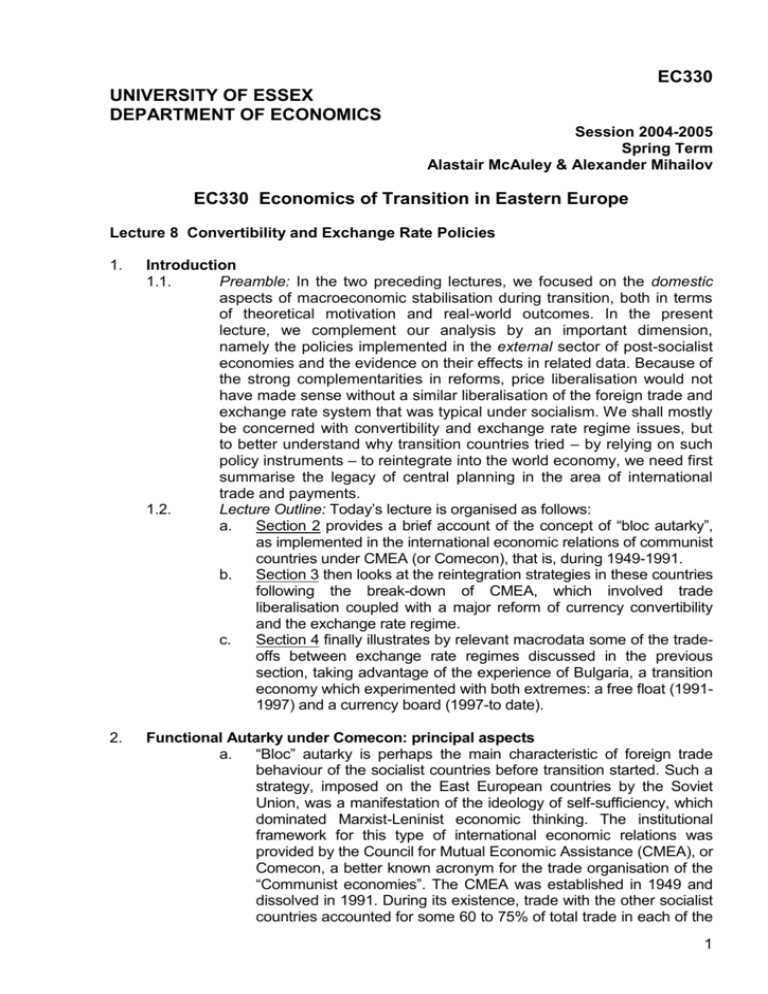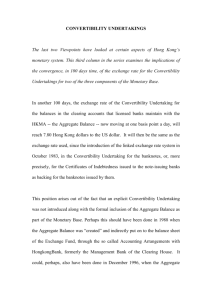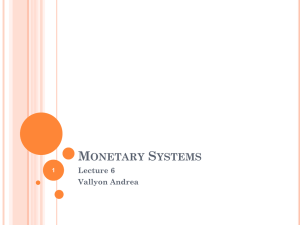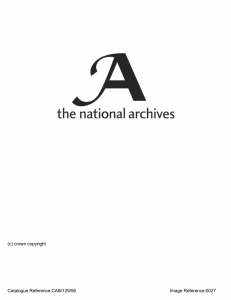EC330 Economics of Transition in Eastern Europe
advertisement

EC330 UNIVERSITY OF ESSEX DEPARTMENT OF ECONOMICS Session 2004-2005 Spring Term Alastair McAuley & Alexander Mihailov EC330 Economics of Transition in Eastern Europe Lecture 8 Convertibility and Exchange Rate Policies 1. Introduction 1.1. Preamble: In the two preceding lectures, we focused on the domestic aspects of macroeconomic stabilisation during transition, both in terms of theoretical motivation and real-world outcomes. In the present lecture, we complement our analysis by an important dimension, namely the policies implemented in the external sector of post-socialist economies and the evidence on their effects in related data. Because of the strong complementarities in reforms, price liberalisation would not have made sense without a similar liberalisation of the foreign trade and exchange rate system that was typical under socialism. We shall mostly be concerned with convertibility and exchange rate regime issues, but to better understand why transition countries tried – by relying on such policy instruments – to reintegrate into the world economy, we need first summarise the legacy of central planning in the area of international trade and payments. 1.2. Lecture Outline: Today’s lecture is organised as follows: a. Section 2 provides a brief account of the concept of “bloc autarky”, as implemented in the international economic relations of communist countries under CMEA (or Comecon), that is, during 1949-1991. b. Section 3 then looks at the reintegration strategies in these countries following the break-down of CMEA, which involved trade liberalisation coupled with a major reform of currency convertibility and the exchange rate regime. c. Section 4 finally illustrates by relevant macrodata some of the tradeoffs between exchange rate regimes discussed in the previous section, taking advantage of the experience of Bulgaria, a transition economy which experimented with both extremes: a free float (19911997) and a currency board (1997-to date). 2. Functional Autarky under Comecon: principal aspects a. “Bloc” autarky is perhaps the main characteristic of foreign trade behaviour of the socialist countries before transition started. Such a strategy, imposed on the East European countries by the Soviet Union, was a manifestation of the ideology of self-sufficiency, which dominated Marxist-Leninist economic thinking. The institutional framework for this type of international economic relations was provided by the Council for Mutual Economic Assistance (CMEA), or Comecon, a better known acronym for the trade organisation of the “Communist economies”. The CMEA was established in 1949 and dissolved in 1991. During its existence, trade with the other socialist countries accounted for some 60 to 75% of total trade in each of the 1 EC330 Lecture 8 Convertibility and Exchange Rate Policies b. c. d. e. f. g. Comecon members, and the biggest part within this percentage range was usually trade with the USSR. However, autarky was not self-sufficiency, neither for any of the CMEA economies, nor for the socialist bloc as a whole. Trade with capitalist countries, or market economies, generally accounted for 10 to 25% of total trade – depending on the particular country or period – even under central planning, with the remaining percentage range, usually 5 to 15%, filled up by developing countries. The system of trade relations of the Comecon countries rather entailed what Holzman (1974) termed in his book Foreign Trade under Central Planning functional autarky, a concept we clarify next. State trading was the essential core of this functional autarky. Under socialism, the state monopoly in the area of foreign trade corresponded to the state ownership over the “means of production” in the entire economy. It was introduced in Russia in April 1918, in the wake of the first nationalisations. It survived, in its traditional form, in most socialist economies until the early 1980s. The foreign trade monopoly meant that only state foreign trade organisations (FTOs) specialised by economic branch or group of products were allowed to handle international trade transactions. Each FTO was subordinated to the ministry of trade and/or attached to the relevant branch within the industrial ministry. It acted like an intermediary between the foreign partner and the domestic enterprise. With capitalist partners, FTOs dealt on the basis of international prices and in foreign currencies. With socialist partners, trade was effected according to CMEA prices and settlement of payments was accounted in transferable roubles (TRs), a form of “credit money” which never physically existed. With national stateowned enterprises (SOEs), finally, transactions were effected in the domestic currency and prices. There were 40 to 60 such FTOs in each centrally planned economy. Soviet FTOs were very large and powerful: Soyuzneftexport was the single largest oil exporter in the world. Reforms of the FTO system started in Hungary and Poland in the early 1980s and were also being implemented during the late 1980s in limited scope in the other socialist countries, including the USSR. Many SOEs thus could trade on their own account, and some of them took advantage of the new opportunities while others, showing less initiative, still relied on their branch FTO. Foreign trade was planned and coordinated at a national and “bloc” level, that is, within the CMEA. When planned domestic resources were insufficient and when it was not easy to save on domestic uses of a good in the standard material balance tables, imports were required. Ways to increase some exports had then to be found, looking at cases where curtailing domestic uses seemed possible. According to Lavigne (1999), such an approach has two aspects. i. Foreign trade is treated as an activity secondary to domestic trade ii. Imports are given priority to exports: a country is supposed to export mainly to pay for its imports. The advantages of international specialisation thus remained largely unexploited. At a certain point in time, this was realised as well by 2 EC330 Lecture 8 Convertibility and Exchange Rate Policies h. i. j. 3. the socialist economic ideologists, who launched in 1971 what they described as a programme of socialist integration within the existing under the CMEA “international socialist division of labour”. This was not, however, a departure from central planning. It was simply a “supra-national” imposition of specialisation requirements by country, which had to be incorporated into domestic planning. The latter should be done i. Either as excess production over the country’s own requirements ii. Or as a deliberate discontinuation of the production of goods which could have been imported from some other socialist partner, “more endowed” in resources for the particular item. This priority given to imports in centrally planned economies until the first oil shock was well-captured by the coinage “import-led growth”, invented by Hanson, 1982, “The End of Import-Led Growth? Some Observations on Soviet, Polish and Hungarian Experience in the 1970s”, Journal of Comparative Economics 6:130-140. By the late 1970s the catchphrase in Eastern Europe had already become “export dynamism”. It was usually interpreted as the need to export much more in order to generate foreign currency by means of which innovative technologies could be imported to spur the meagre socialist growth. As Wolf (1998) has rightly put it in his book Foreign Trade in the Centrally Planned Economy, since socialist countries were constrained by the shortage of foreign currency, they had to export first so as to be in a position to import later. The above point leads us to a last feature of the functional autarky we would briefly summarise, namely the inconvertibility of socialist currencies. These currencies were inconvertible in the sense that they could not be purchased or sold against other currencies i. at a single exchange rate ii. without restrictions iii. and for all purposes Thus, there are degrees of inconvertibility or – which is an equivalent statement – of convertibility. Inconvertibility under socialism should therefore be understood as mostly relating to the prohibition of households to maintain foreign currency accounts at banks (domestic as well as foreign) and to effect exchanges of money for any other purpose except tourism. As for FTOs and SOEs, these were certainly allowed to maintain accounts in foreign currencies to effect payments related to their transactions, but a huge part of the proceeds had to be kept at banks within the national territory, in particular on accounts with the specialised Foreign Trade Bank that enjoyed the monopoly on payments abroad in each of these economies under orthodox socialism. Reintegrating into the World Economy: Convertibility and Exchange Rate Regimes during Transition a. When communism collapsed, the CMEA system of bloc autarky broke down almost immediately, i.e. as early in the process of transition reforms as 1991. The state monopoly was abolished and trade was liberalised. The post-socialist countries, wishing to be quickly reintegrated into the world economy, also subjected their 3 EC330 Lecture 8 Convertibility and Exchange Rate Policies b. exchange rate management policies to a radical change. Convertibility was introduced soon, although in steps of increasing degrees. Exchange rates – maintained during socialism at an overvalued official level (itself multiplied by various “coefficients” for sector, origin or purpose of the transaction, hence multiple rates) – were partly liberalised in the late 1980s by an introduction of more realistic “commercial” (applied to imports and exports of goods) and “financial” (applied to capital flows) rates. These were then either left free of intervention so that the forces of the market could determine which is the appropriate unified rate (in countries with few international reserves) or fixed to a substantially devalued levels (in countries with enough reserves). We consider next the key ingredients of such external sector reforms in transition economies. Convertibility i. As we already said, there are degrees between inconvertibility and convertibility of a currency, according to a small set of criteria including essentially the purpose of transaction. The IMF distinguishes two major types of convertibility, which correspond to the two component accounts of the balance of payments (BoP) statement: 1. current account convertibility: exchange of currency is allowed for effecting payments on transactions classified in the current account of the BoP, i.e. a. goods, e.g. imports b. services, such as transport and travel abroad 2. capital account convertibility: exchange of currency is allowed for effecting payments on transactions classified in the capital account of the BoP, i.e. a. foreign direct investment (FDI), e.g. building a factory abroad b. portfolio investment, e.g. buying a foreign government or corporate bond 3. various additional degrees of convertibility have also been observed in the practice of transition economies: a. the direction of the transaction may matter, e.g. foreign residents can buy national currency for a given purpose but not vice versa b. the horizon of the investment may matter as well: long-run investments such as FDI have generally been favoured by transition economies and in some of them a corresponding phased liberalisation of the capital account has been implemented 4. moreover, most post-socialist countries have introduced (unlimited) current account convertibility rather early in the reforms, whereas progress towards capital account convertibility has been made much later in stages 5. the various forms of capital account convertibility restrictions are also known in the academic literature as capital controls. ii. The arguments in favour of a quick introduction of current account convertibility in transition economies have mostly been associated with: 4 EC330 Lecture 8 Convertibility and Exchange Rate Policies 1. c. importing the correct relative price structure from the world economy (recall that the centrally fixed prices in domestic plans as well as under CMEA agreements were largely disconnected from world market prices), thus stimulating local industries with comparative advantage 2. strengthening the commitment of governments to liberalise domestic prices, due to arbitrage if internal prices remained centrally imposed at a different level iii. As for capital account convertibility during transition, the enthusiasm of reformers was much less obvious. This is in line with certain recommendations in the Washington consensus tradition that there may be some disadvantages of such a high degree of convertibility, the more so in the initial stages of transition. In particular, it was pointed out that: 1. newly liberalised currencies (as well as new currencies, as those introduced in former USSR and Yugoslav republics) remained vulnerable to speculative attacks and capital flight 2. monetary policy becomes far less effective as a tool of macroeconomic policy, hence a huge burden falls on fiscal policy Exchange Rate Regimes i. Theory usually represents the types of, and trade-offs between, exchange rate regimes as float versus peg, i.e. flexible versus fixed exchange rate regime. 1. Under the first regime, (pure) float, the central bank leaves the value of the national currency to be completely determined by the market. 2. Under the second regime, (credible) peg, it by contrast officially engages to maintain a constant exchange rate against a foreign currency or a basket of currencies (usually of the major trading partners). This is, of course, possible: a. only if the central bank has enough foreign exchange reserves to intervene in forex markets b. and only to certain limits, defined by the underlying exchange rate “fundamentals”, i.e. the key macroeconomic factors determining a given “justified” level of the national currency in any particular moment in time ii. In practice, policy makers rather conform to a regime that is neither (pure) float, nor (permanent) peg. Instead, one usually talks of managed or “dirty” floats, or of adjustable or “crawling” pegs. As an extreme case at the fixed end of the exchange rate regime spectrum one finds the currency board, a last stage in which the government is still keeping its national currency, although with practically no much leeway to influence its value (which is, in essence, the rationale for this particular regime). Beyond this frontier, the national currency has to be surrendered, i.e. replaced by another, foreign currency: either through a monetary union (e.g. the euro in the Euro-zone) or through “dollarisation” (e.g. Panama). 5 EC330 Lecture 8 Convertibility and Exchange Rate Policies iii. iv. v. vi. As far as exchange rate regime choices of transition economies are concerned, the East European nations have embarked on accession strategies leading to an ultimate monetary union with the EMU. In many cases, this has been the implicit exchange rate strategy right from the start of reforms. No matter the common final target, the trajectories to it have differed, in general economic terms as well as with respect to the exchange rate policies implemented. In the early stages of reform, a rather heated debate spurred on the initial level of devaluation and the related choice of exchange rate management during post-socialist transition. Even theoretically, definitions of what should be considered the “equilibrium” exchange rate and of which is an “optimal” exchange rate policy have varied and the issues remain unresolved. IMF has tended to support a peg in its “pragmatic” stabilisation programmes, mostly to help reduce inflationary expectations. Others have argued in favour of a float, mainly because of the danger that a fixed exchange rate could undermine export performance under continuing domestic inflation in transition countries higher than in major trading partners (the problem of real appreciation). This debate has calmed down ever since, as it turned out that the success or failure of a transition path from plan to market (or to EU accession, in a more concrete sense) is not crucially dependent on the choice of exchange rate regime only. Both regimes have their advantages and inconveniences, and these have been more or less discussed in the course of reforms. Neither of them is a panacea. Which of them to choose and to what “purity” to implement it has become a matter of constraints in terms of economic realities and strategies of transition. Not one country has kept its initial choice unmodified, and some, such as Bulgaria to which we return with illustrative purposes in the final section, have experimented with both extremes. Fixed exchange rate (or peg) 1. key advantages a. by stabilising the exchange rate, contributes to less uncertainty (volatility) in the overall macroeconomic situation of a country and therefore facilitates optimising decisions by agents (but may hamper adjustment to external shocks…) b. helps fight inflation, and could thus be used as a “nominal anchor” in transition reforms: by committing to a peg, a monetary authority binds itself not to inflate at a rate higher than world inflation, thus “importing“ policy credibility from a central bank with low-inflation reputation c. it, however, can also “import” any negative tendencies in the world economy into the domestic economy 2. an extreme form of such a fixed regime is the currency board that became popular in some transition economies 6 EC330 Lecture 8 Convertibility and Exchange Rate Policies vii. 4. (first Estonia, then Latvia and Bulgaria): it involves a legal commitment of the central bank to hold foreign reserves at least equal to the monetary base at the fixed exchange rate (in such a way linking directly any monetary expansion to the accumulation of reserves) Flexible exchange rate (or float): its advantages are a mirror image of the disadvantages of the peg and its disadvantages are simply the advantages of the fixed exchange rate regime inversed: 1. key advantages a. by allowing adjustment to shocks, ensures automatic equilibrium of the BoP (but may be too volatile and provoke inflationary episodes…) b. permits the formulation and implementation of autonomous monetary policy c. “immunises” the domestic economy against “outside” business cycles 2. Less flexible exchange rate arrangements are often referred to as managed floats or adjustable pegs. These occupy the “intermediate ground” between a true float and a credible peg. Such arrangements, often observed in the practice of post-socialist reforms, combine the benefits but also the risks of each of the above “pure” cases of exchange rate regimes. a. A popular variety at various stages of transition has been the so-called crawling peg, or rather crawling band: in such a regime, a weak and gradual depreciation of the national currency against a basket of the currencies of the major trade partners was preannounced (within a permissible band) and then implemented, e.g. in Poland since October 1991 (initially reforms started under a peg). b. In Hungary, a similar arrangement called an adjustable peg has operated until April 1995, in which devaluations are not preannounced but remain weak and happen at irregular intervals depending on the economic fundamentals. Illustrating Some of the Trade-offs between a Float and a Peg: the transition experience of Bulgaria 4.1. We choose here Bulgaria as a useful pedagogic illustration on the relative merits of exchange rate regimes. The country is unique among transition economies in that it has experimented with both extremes of a rather pure float (February 1991 – June 1997), as no sufficient reserves allowed effective intervention, and a credible peg in the form of a currency board (June 1997 – to date). 4.2. Bearing in mind the overall context of our previous discussion, we shall only briefly point to several interesting trends in the data. Given the controversial debates and ambiguous evidence on the difficult topic of (welfare) comparisons of exchange rate regimes, we would refrain from attempts to generalise or theorise. 7 EC330 Lecture 8 Convertibility and Exchange Rate Policies a. b. During the float period, February 1991 to June 1997, the following trends seem worth mentioning: i. Looking at the level of foreign exchange reserves at the beginning of transition reforms, we could say that Bulgaria had no other choice but to introduce a flexible regime for the lev. ii. The quarterly lev/dollar (end of period) exchange rate and the CPI have tended to broadly move together. This high correlation does not necessarily mean causation, though. In fact, depreciation episodes have induced or accelerated inflationary episodes and vice versa. The huge jump in both series is coincident in the winter of 1996-1997, the hyperinflationary episode which led to the adoption of the currency board in Bulgaria. iii. Turning to the current account, it has been roughly in balance (with the exception of 1993). This may to some extent support our claim above that a float helps the automatic adjustment to external shocks. iv. In terms of accumulation of reserves, what has been received mostly from the IMF as reform-supporting loans has been lost in the banking crisis of 1996 and the subsequent hyperinflation. At that stage (as well as in earlier episodes, e.g. in 1993), the float has not been pure at all, as the central bank was trying to stop the lev from depreciating. During the currency board period, July 1997 to date, we would enumerate comments corresponding to those in the preceding paragraph: i. Reserves have grown at an impressive rate (of course, not only because of the stable lev, yet to a large extent due to it). ii. The CPI has tended to move again in rough synchrony with the lev, itself fixed to the euro and hence following the euro/dollar trends (a graph showing the lev/euro rate will certainly be a straight line, a well-known fact about currency boards). A comparison of the scales of the corresponding graphs in figures 8.1 and 8.2 will convince that the movements in both the CPI and the lev/dollar exchange rate have been miniscule during the currency board period relative to the float period. A credible peg does seem to help in containing inflation… iii. … But a major trade-off is that, due to some real appreciation (as we mentioned when considering the theoretical arguments in the choice of exchange rate regimes), the current account has definitely gone into deterioration… iv. … The good news is, however, the huge increase in reserves. Over a longer run, the sustainability – hence, credibility – of the chosen level for the peg (or currency board) will depend on the extent to which the inflows of (equity) capital (on the financial account and the official account of the BoP) would compensate for the current account deficits, so that foreign debt is not increased but properly serviced and hopefully reduced… v. A common feature of the experience with currency boards in transition – not only in Bulgaria but also in Estonia and Latvia – is that, by ensuring macroeconomic stability, they have tended to help restore (relatively high) growth relatively quickly. 8 EC330 Lecture 8 Convertibility and Exchange Rate Policies Bulgaria under Float, February 1991- June 1997 ( Source: IFS ESDS) 400 2800 200 2400 2000 0 1600 -200 1200 -400 800 -600 400 -800 1991 1992 1993 1994 1995 1996 1997 0 1991 1992 1993 1994 current account balance, mln USD 1995 1996 1997 1995 1996 1997 CPI 1600 2.0 1400 1.6 1200 1.2 1000 800 0.8 600 0.4 400 200 1991 1992 1993 1994 1995 1996 1997 0.0 1991 1992 foreign exchange reserves, mln USD 1993 1994 exchange rate, eop, ( 1000 x) BGL per 1 USD Figure 8.1 Bulgaria under Currency Board, July 1997 - to date 400 4000 200 3800 0 3600 -200 3400 -400 3200 -600 3000 -800 2800 1998 1999 2000 2001 2002 2003 1998 1999 2000 current account balance, mln USD 6000 2001 2002 2003 2002 2003 CPI 2.4 2.3 5000 2.2 2.1 4000 2.0 3000 1.9 1.8 2000 1.7 1000 1.6 1998 1999 2000 2001 2002 2003 1998 foreign exchange reserves, mln USD 1999 2000 2001 exchange rate, eop, BGL per 1 USD Figure 8.2 9






